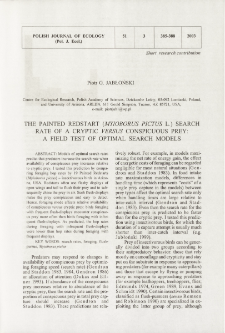- Wyszukaj w całym Repozytorium
- Piśmiennictwo i mapy
- Archeologia
- Baza Młynów
- Nauki przyrodnicze
Wyszukiwanie zaawansowane
Wyszukiwanie zaawansowane
Wyszukiwanie zaawansowane
Wyszukiwanie zaawansowane
Wyszukiwanie zaawansowane

Obiekt
Tytuł: The painted redstart (Myioborus pictus L.) search rate of a cryptic versus conspicuous prey: a field test of optimal search models
Inny tytuł:
Search for conspicuous versus cryptic prey
Współtwórca:
Polish Academy of Sciences. Institute of Ecology
Wydawca:
Polish Academy of Sciences. Institute of Ecology. Publishing Office
Miejsce wydania:
Opis:
Strony 385-388 : ilustracje ; 27 cm ; Bibliografia na stronie 388
Typ obiektu:
Abstrakt:
Models of optimal search rates predict that predators increase the search rate when availability of conspicuous prey increases relative to cryptic prey. I tested this prediction by comparing foraging hop rates by 19 Painted Redstarts (Myioborus pictus) - insectivorous birds in Arizona, USA. Redstarts often use flashy displays of open wings and tail to flush their prey and to subsequently chase the prey in air. Such flush-displays make the prey conspicuous and easy to detect. Hence, foraging mode affects relative availability of conspicuous versus cryptic prey: birds foraging with frequent flush-displays encounter conspicuous prey more often then birds foraging with infrequent flush-displays. As predicted, the hop rates during foraging with infrequent flush-displays were lower than hop rates during foraging with frequent displays.
Bibliografia:
Barber M. B., Barber D. R., Jabłoński P. G. 2000 - Painted Redstart (Myioborus pictus). No. 528 (In: Birds of North America, Eds. A. Poole, F.Gill) - The Academy of Natural Sciences, Philadelphia, PA and The American Ornithologist's Union, Washington D.C.
Dukas R., Ellner S. 1993 - Information processing and prey detection - Ecology, 74: 1337-1346.
Evans D. L., Schmidt J. O. 1990 - Insect defenses. Adaptive Mechanisms and Strategies of Prey andPredators - State University of New York Press, New York.
Edmunds M. 1974 - Defense in Animals. A survey of anti-predator defenses - Longmann Ltd., Harlow, Essex.
Gendron R. P., Staddon J. E. R. 1983 - Searching for cryptic prey: the effect of search rate - Am. Nat. 121: 172-186.
Gendron R. P., Staddon J. E. R. 1984 - A laboratory simulation of foraging behavior: the effect of search rate on the probability of detecting prey - Am. Nat. 124: 407-415.
Gendron R. P. 1986 - Searching for cryptic prey: evidence for optimal search rates and the formation of search images in quail - Anim. Behav. 34: 898-912.
Green E. 1989 - Food resources, interspecific aggression, and community organization in a guild of insectivorous birds - Ph.D. Dissertation, Princeton University, Princeton.
Jabłoński P. G. 1996 - Dark habitats and bright birds: warblers may use wing patches to flush prey - Oikos, 75: 350-352.
Jabłoński P. G. 1999 - A rare predator exploits prey escape behavior: the role of tail-fanning and plumage contrast in foraging of the painted redstart (Myioborus pictus) - Behav. Ecol. 10: 7-14.
Jabłoński P. G. 2001 - Sensory exploitation of prey: manipulation of initial direction of prey escapes by a conspicuous "rare enemy" - Proc. Roy. Soc. London, B, 268: 1017-1022.
Jabłoński P. G. 2002 - Searching for conspicuous versus cryptic prey: a field study and a review of search rates of flush-pursuing versus substrate-gleaning birds - Condor, 104: 657-661.
Jabłoński P. G., Strausfeld N. J. 2000 - Exploitation of an ancient escape circuit by an avian predator: prey sensitivity to model predator display in the tield - Brain Behavior and Evolution, 56: 94-106.
Jabłoński P. G., Strausfeld N. J. 2001 - Exploitation of an ancient escape circuit by an avian predator: relationships between taxon-specific prey escape circuits and the sensitivity to visual cues from the predator - Brain Behavior and Evolution, 58: 218-240
Keast A., Pearce L., Saunders S. 1995 - How convergent is American Redstart (Setophaga ruticilla, Parulinae) with fiycatchers (Tyrannidae) in morphology and feeding behavior? - Auk, 112: 310-325.
Remsen J. V., Robinson S. K. 1990 - A classification scheme for foraging behavior of birds in terrestrial habitats - Stud. Avian Biol. 13: 144-160.
Rice W. R. 1989 - Analyzing tables of statistical tests - Evolution, 43: 223-225.
Rice W. R., Gaines S. D. 1994 - Heads I win, tails you lose: testing directional alternative hypotheses in ecological and evolutionary research - Trends Ecol. Evol. 9: 235-237.
Zar J. H. 1999 - Biostatistical Analysis Prentice - Hall lnt, Inc., Englewood Cliffs.
Czasopismo/Seria/cykl:
Tom:
Zeszyt:
Strona pocz.:
Strona końc.:
Szczegółowy typ zasobu:
Identyfikator zasobu:
Źródło:
MiIZ PAN, sygn. P.2840 ; kliknij tutaj, żeby przejść
Język:
Język streszczenia:
Prawa:
Licencja Creative Commons Uznanie autorstwa 3.0 Polska
Zasady wykorzystania:
Zasób chroniony prawem autorskim. [CC BY 3.0 PL] Korzystanie dozwolone zgodnie z licencją Creative Commons Uznanie autorstwa 3.0 Polska, której pełne postanowienia dostępne są pod adresem: ; -
Digitalizacja:
Muzeum i Instytut Zoologii Polskiej Akademii Nauk
Lokalizacja oryginału:
Biblioteka Muzeum i Instytutu Zoologii PAN
Dofinansowane ze środków:
Dostęp:
Kolekcje, do których przypisany jest obiekt:
- Repozytorium Cyfrowe Instytutów Naukowych > Kolekcje Partnerów > Muzeum i Instytut Zoologii PAN > Czasopisma
- Repozytorium Cyfrowe Instytutów Naukowych > Piśmiennictwo > Czasopisma/Artykuły
Data ostatniej modyfikacji:
4 lut 2025
Data dodania obiektu:
18 mar 2020
Liczba pobrań / odtworzeń:
106
Wszystkie dostępne wersje tego obiektu:
https://rcin.org.pl./publication/91641
Wyświetl opis w formacie RDF:
Wyświetl opis w formacie RDFa:
Wyświetl opis w formacie OAI-PMH:
Obiekty Podobne
Kruuk, H. Hewson, R.
Bright, P. W. Morris, P. A.
Venkataraman, A. B. Armugam, R. Sukumar, R.
Doolan, S. P. Macdonald, D. W.
Abensperg-Traun, M. De Boer, E. S.
Bonesi, L. Dunstone, N. O'Conell, M.
Jones, G. Morton, M. Hughes, P. M. Budden, R. M.

 INSTYTUT ARCHEOLOGII I ETNOLOGII POLSKIEJ AKADEMII NAUK
INSTYTUT ARCHEOLOGII I ETNOLOGII POLSKIEJ AKADEMII NAUK
 INSTYTUT BADAŃ LITERACKICH POLSKIEJ AKADEMII NAUK
INSTYTUT BADAŃ LITERACKICH POLSKIEJ AKADEMII NAUK
 INSTYTUT BADAWCZY LEŚNICTWA
INSTYTUT BADAWCZY LEŚNICTWA
 INSTYTUT BIOLOGII DOŚWIADCZALNEJ IM. MARCELEGO NENCKIEGO POLSKIEJ AKADEMII NAUK
INSTYTUT BIOLOGII DOŚWIADCZALNEJ IM. MARCELEGO NENCKIEGO POLSKIEJ AKADEMII NAUK
 INSTYTUT BIOLOGII SSAKÓW POLSKIEJ AKADEMII NAUK
INSTYTUT BIOLOGII SSAKÓW POLSKIEJ AKADEMII NAUK
 INSTYTUT CHEMII FIZYCZNEJ PAN
INSTYTUT CHEMII FIZYCZNEJ PAN
 INSTYTUT CHEMII ORGANICZNEJ PAN
INSTYTUT CHEMII ORGANICZNEJ PAN
 INSTYTUT FILOZOFII I SOCJOLOGII PAN
INSTYTUT FILOZOFII I SOCJOLOGII PAN
 INSTYTUT GEOGRAFII I PRZESTRZENNEGO ZAGOSPODAROWANIA PAN
INSTYTUT GEOGRAFII I PRZESTRZENNEGO ZAGOSPODAROWANIA PAN
 INSTYTUT HISTORII im. TADEUSZA MANTEUFFLA POLSKIEJ AKADEMII NAUK
INSTYTUT HISTORII im. TADEUSZA MANTEUFFLA POLSKIEJ AKADEMII NAUK
 INSTYTUT JĘZYKA POLSKIEGO POLSKIEJ AKADEMII NAUK
INSTYTUT JĘZYKA POLSKIEGO POLSKIEJ AKADEMII NAUK
 INSTYTUT MATEMATYCZNY PAN
INSTYTUT MATEMATYCZNY PAN
 INSTYTUT MEDYCYNY DOŚWIADCZALNEJ I KLINICZNEJ IM.MIROSŁAWA MOSSAKOWSKIEGO POLSKIEJ AKADEMII NAUK
INSTYTUT MEDYCYNY DOŚWIADCZALNEJ I KLINICZNEJ IM.MIROSŁAWA MOSSAKOWSKIEGO POLSKIEJ AKADEMII NAUK
 INSTYTUT PODSTAWOWYCH PROBLEMÓW TECHNIKI PAN
INSTYTUT PODSTAWOWYCH PROBLEMÓW TECHNIKI PAN
 INSTYTUT SLAWISTYKI PAN
INSTYTUT SLAWISTYKI PAN
 SIEĆ BADAWCZA ŁUKASIEWICZ - INSTYTUT TECHNOLOGII MATERIAŁÓW ELEKTRONICZNYCH
SIEĆ BADAWCZA ŁUKASIEWICZ - INSTYTUT TECHNOLOGII MATERIAŁÓW ELEKTRONICZNYCH
 MUZEUM I INSTYTUT ZOOLOGII POLSKIEJ AKADEMII NAUK
MUZEUM I INSTYTUT ZOOLOGII POLSKIEJ AKADEMII NAUK
 INSTYTUT BADAŃ SYSTEMOWYCH PAN
INSTYTUT BADAŃ SYSTEMOWYCH PAN
 INSTYTUT BOTANIKI IM. WŁADYSŁAWA SZAFERA POLSKIEJ AKADEMII NAUK
INSTYTUT BOTANIKI IM. WŁADYSŁAWA SZAFERA POLSKIEJ AKADEMII NAUK




































